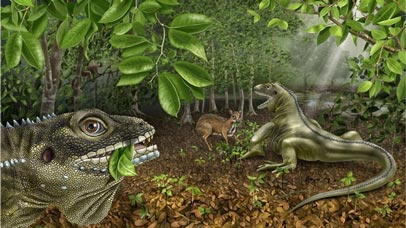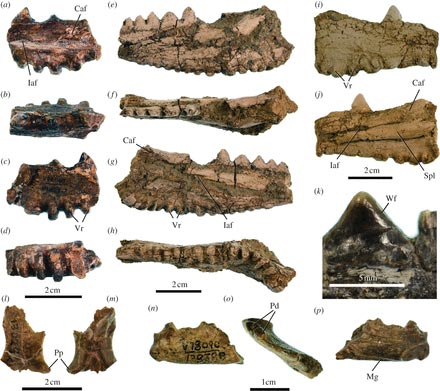Jim Morrison Honoured by Having a Prehistoric Lizard Named After Him
A few weeks ago we reported on the naming of a new genus of arthropod after the film star Johnny Depp. The Cambrian creature, a distant relative of today’s lobsters was named Kooteninchela deppi, as the scissor-like appendages found at the front part of the animal’s body reminded scientists of the titular character in the film Edward Scissorhands, a role played by Johnny Depp.
To read more about the arthropod named in honour of this actor: Fossil Named after Actor in Edward Scissorhands Role.
Barbaturex morrisoni
Now the singer/songwriter Jim Morrison, the front man of the “The Doors”, who died in 1971, is being honoured with the naming of an extinct, giant herbivorous lizard after him. Jim Morrison had the epithet “The Lizard King” and this newly described Squamate, a member of a group whose extant members include Agamids and Iguanas, was certainly a “king-sized herbivore”, weighing in at near to thirty kilogrammes.
The terrestrial reptile, lived in south-east Asia from between 40 and 36 million years ago (Eocene Epoch), it has been named Barbaturex morrisoni, the name means “Morrison’s bearded king”, in reference to ridges found on parts of the creature’s mandible, its large size and the American rock star.
Barbaturex morrisoni – Able to Compete Against Mammalian Ungulates
Picture credit: Angie Fox
Probably Herbivorous
This large lizard was very probably herbivorous, the research team led by Dr Jason Head from the University of Nebraska-Lincoln (United States), claim. The warmer temperatures of the Late Eocene Epoch permitted lizards to reach such large sizes and although the mammals were diversifying rapidly, it seems this large, plant-eating lizard was more than able to hold its own against them. The scientists have stated that this is the largest, herbivorous lizard known to science.
The research team examined the fauna of this ancient jungle ecosystem and found that Barbaturex was larger than most of the carnivorous mammals and bigger than many of the mammalian herbivorous that shared its habitat. Competition for resources did not appear to restrict its evolution.
Many types of lizard today, such as the agamids and the iguanas are much smaller than mammalian herbivores in their environment, they are also predated by larger mammalian carnivores.
Co-author of the study, Professor Russell Ciochon (University of Iowa), commented:
“Reptiles and mammals co-exist most places on the Earth today. What is interesting about the “Lizard King” is that it was a large vegetarian co-existing and competing with other herbivorous mammals. Large lizards on the Earth today, such as Indonesia’s Komodo Dragon, and in the past, such as the Late Cretaceous Chinese Chianghsia nankangensis and the Pleistocene Australian Varanus priscus, are all carnivores. These large carnivorous lizards were eating the mammals they co-existed with, not competing with the mammals. The large size of the “Lizard King” certainly protected it from many predators. But there is no doubt that it was hunted by mammalian carnivores of the day.”
Examples of the Fossil Material – Elements of the Jaw
Picture credit: Proceedings of the Royal Society B (Biology)
The Squamata
The Order Squamata (lizards and snakes) can still surprise scientists even today, with new species being found occasionally, after all this Order of reptiles is the most diverse, most numerous Order of reptiles on the planet. In 2010, scientists working on the Philippine island of Luzon announced the discovery of a new species of Monitor Lizard, one that could reach lengths in excess of two metres. This lizard, named Varanus bitatawa, lives in the tree canopy and rarely ventures onto the ground, it too, like Barbaturex morrisoni is a vegetarian, although it weighs less than ten kilogrammes and much of its impressive two-metre length is made up of its long tail.
To read about the discovery of this new Monitor species: New Species of Vegetarian Lizard Discovered in the Philippines.
Dr Head explained that it was important to study past climates and ecosystems so that scientists can learn about today’s habitats and the interactions between faunas and floras. During the Eocene, the average global temperature on the Earth was much higher than today, at around 20 degrees Celsius, the warm climate allowed the evolution of a large body size and the ability of lizards to successfully compete against the rapidly diversifying mammalian faunas.
The doctor then went onto explain how this new species got its name:
“I was listening to The Doors quite a bit during the research. Some of their musical imagery includes reptiles and ancient places, and Jim Morrison was of course ‘The Lizard King’, so it all kind of came together.”
Giant Lizards in the Future?
Average global temperatures today are around 14 degrees Celsius, however the scientists did not rule out the evolution of giant, herbivorous lizards in the future. If global warming continues and the Earth does warm up and rain-forests and other tropical habitats come to dominate than the Squamata may well have representatives within it that are regarded as giant forms.
The fossils found in strata associated with the Pondaung Formation (Burma otherwise known as Myanmar), suggest that back in the Eocene this part of the world may have been as much as 5 degrees Celsius warmer than it is today. The fossils, which include a lot of cranial and jaw material were found close to the village of Mogaung in the district of Sagaing, the scientists are keen to continue to their studies so that they can learn more about the ancient fauna that once roamed Eocene jungles.
For figures and models of extinct reptiles and other prehistoric creatures: Everything Dinosaur Models and Figures.







Leave A Comment